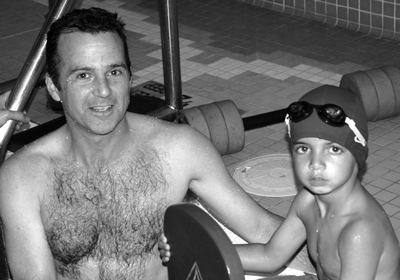By Judith Stiles
For some city dwellers on a hot summer day, the idea of a dip in the local pool is not a refreshing thought at all. Rather, it can be a very scary proposition for one who never learned how to swim. Sometimes, one bad pool experience as a child can fester and last into the teen years, and by adulthood can become a full-blown water phobia.
But fear not, city landlubbers. It is never too late to take swimming lessons, even if your birthday count is way past 50. At the Sol Goldman Y on E. 14th St., the new director of aquatics, Bob Hawthorn, has a gentle and cajoling approach when acclimating novices to the pool. He welcomes the fearful of all ages to try his one-on-one lessons.
“You are never too old to learn to swim,” says Hawthorn in a reassuring tone. “With several of my older students, the first step is to make them realize the water does not have a sudden drop-off and that they can slowly and safely enter deeper waters.” Hawthorn fondly recalls his first experience with swimming when his father held his hand going into the rollicking waves of Jones Beach. He tries to recreate this comfort zone that he had as a child, as he introduces nervous adults to swimming.
For the little ones, ages 6 months to 2 years, he leads a class in the pool called
“Baby Belugas,” in which a parent or caregiver is active in the process. They sing swim songs, such as “Jack Be Nimble,” which is often a good distraction for the young ones who are not quite ready to take the plunge. The “Little Dippers,” ages 2 to 4 years, have fun with brightly colored flotation devices, which help them feel comfortable in the water. A good deal of time is devoted to educating the caregivers in water safety.
“One of the first things I do is orient the adults about water safety, and I remind them how in a split second a child can move into the water, right into a very hazardous situation,” emphasizes Hawthorn. “Parents don’t realize that even in the moment of giving a bath, turning around or reaching up to get something in a cabinet, a child can drown,” he adds.
Trained by the Red Cross in water safety, C.P.R. and baby C.P.R., plus years of experience as a certified lifeguard in Suffolk County, Hawthorn recommends swimmers stick to a simple set of guidelines for a safe summer, whether one is going to the beach or the pool. Hawthorn’s tips:
1. If your child is swimming, always maintain visual contact. Don’t fall into the careless habit of trying to read the newspaper, etc.
2. Use the buddy system, keep contact with your buddy, and let your buddy know if you plan to leave the water.
3. Grandma’s old adage of not swimming after you eat because of cramping is not necessarily true. He points out that the body slows down after a meal along with reaction time, so Grandma was correct in advising to wait before swimming after a meal.
4. In open water, only swim where there is a lifeguard.
5. In open water, do not swim straight out into deep water. It is better to swim parallel to the shore.
6. If you are swimming outdoors, use plenty of sun block and try and avoid swimming between 11 a.m. and 2 p.m., when the sun’s rays are strongest.
7. If you go for a vigorous, rapid-paced swim, don’t stop swimming abruptly. Wind down with a slower stroke, which is commonly called the “cool down.”
If you are stuck in the city, remember, the ocean is only a subway ride away. Hop on the A train, and from Greenwich Village, it takes about an hour to Rockaway Beach in Queens. The D train will take you to Coney Island in Brooklyn, and The Long Island Railroad goes to Jones Beach, a public park that has miles of beautiful beach, as well as an outdoor swimming pool.
If sweltering in the sun is not your thing, but you have a hankering to frolic in some water to cool off, forget the bathtub, and try the open sessions or family swim at the Sol Goldman Y. Seven days a week you can splash in the water, and never have to worry about bringing the sun block.




































